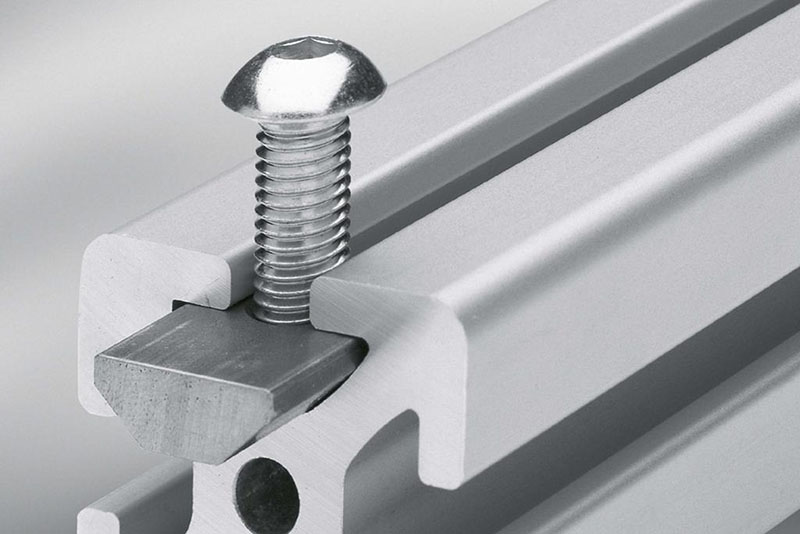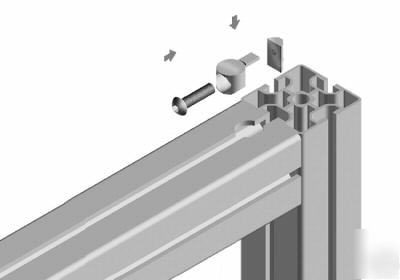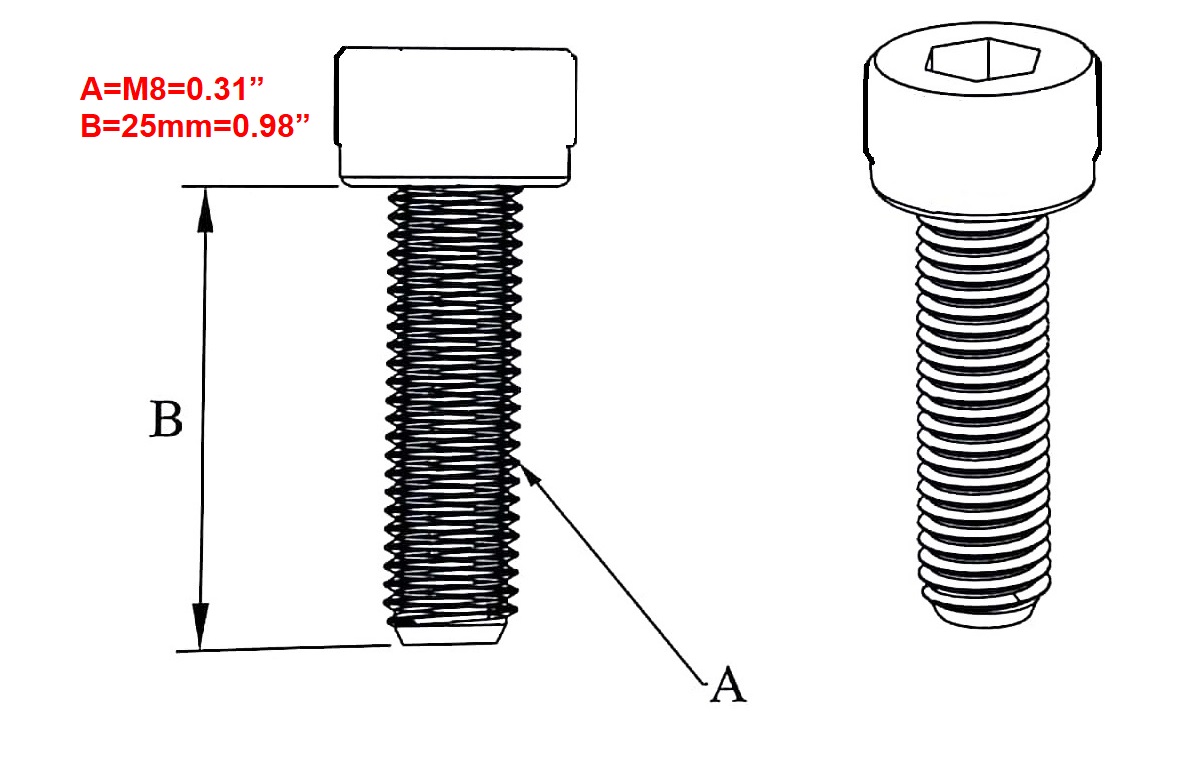This quick training video (#1) will give you the basics of our anchor and end fastener systems. Use these to create your frames for workstations, enclosures. Home / t-slot fasteners / anchor fasteners anchor fasteners. 10 series (5) 15 series (8) 30 series (1) 40 series (2). Boeray Metric M6 x 25mm Thread T Slot Drop-in Bolt T-Bolt Hammer Head Bolt T Screw Stud for 3030 Series Standard 8mm T-Slot Aluminum Extrusion Profile Pack of 50 5.0 out of 5 stars 1 $20.99 $ 20.
- Metric T Slot Aluminum Profiles
- Connectors
- Fasteners
- Accessories
- Frame to Floor
- Panel Accessories
- CarboSix Carbon Fiber
T-Slot Aluminum, T-Bolts and Fastening Nuts
Framing Tech is proud to offer a full line of aluminum framing fasteners, from T-slot aluminum and T-slot extrusion pieces to economy nuts and specialty fasteners.
We know that different aluminum framing projects require varying fastening pieces, that's why we offer a number of options to our valued customers. For the most economic solution, take a look at our economy nuts that are durable and inexpensive and make a perfect joint right where you need it. Or, for more specific framing needs, take a look at our T-Nuts and Drop-In T-Nuts.
We are confident that we have the piece that you are looking for - and if you don't see it here on our website, just give us a call and we'll be happy to find it for you. Here are some of the benefits of using our fasteners with your extruded aluminum project.
The mummy casino slots real money. The Mummy Slots is not just another slot machine game based on an Egyptian theme. This game, developed by Playtech, is actually based on the Hollywood blockbuster movie ‘The Mummy' that was released in 1999, featuring the well-known actors Brendan Frazer and Rachel Weisz. Enjoy lots of incredible bonus features including interactive mummy hunts, special extra bonus options you can collect and activate at will during the main game, bonus spins and collapsing reels, and a jackpot up to 10,000x your stake. A Slot that Combines Thrills, Spills & Swashbuckling Adventures Once you start this intriguing five- reel, 25- payline machine, based on the Hollywood blockbuster, you will certainly notice that it boasts a whole host of lucrative in-game features.
The last time I guided Denali my team came upon a crevasse-rescue effort by another party. They were using a snow anchor but it could have gone dreadfully wrong.
From hundreds of yards away we could see two climbers trying to rescue their partner by pulling against the anchor with their backs towards the lip of the crevasse.
Unbeknownst to them, they were multiplying the forces on their anchor and only adding friction to their pulling efforts. With two of them pulling on the rope against the anchor it could have failed, which would have been catastrophic. Fortunately we got to them quickly and pulled the climber out in less than 15 minutes.
Snow is a weak link. Stack the odds in your favor with the following tips to build solid snow anchors. In a crevasse rescue scenario this will increase your safety margin tenfold!
Building Solid Snow Anchors
The snow picket is a standard piece of equipment for traveling on glaciers and for steep snow climbing where anchoring in the snow for belays is likely.
Traveling in glaciated terrain with only a single partner, it's a very good idea for both climbers to carry a picket for crevice rescue purposes. Traveling with a rope team of 3 or more, one picket per team will suffice for crevice rescue as there will be ice axes available for anchors if need be.
How many snow pickets should you bring to protect a climb?
It all depends. On the aforementioned Denali climb, I 'fixed' the traverse across Denali Pass with 17 pickets!
Obviously, there are many factors to consider when deciding how many pickets to bring. The right answer is usually 'it depends.'
Materials commonly used to construct a solid and equalized two-piece snow anchor:
Why two-piece snow anchors? Redundancy is always a good idea. Always back-up your snow anchors unless you are absolutely certain that the condition of the snow is ideal to withstand the greatest possible load.
- 18' Sterling 5.9mm PowerCord,
- 2-3 locking carabiners
- 1 snow picket. Yates makes a cable picket that is superior to the standard expedition-style picket but for simplicity sake we'll focus on a basic kit.
- Quality ice axe with an adze. (A light racing-style ice axe is not designed to be used as an anchor. I've seen them bend in half!)
Unless the snow is bullet-proof, building a T-Slot, or horizontal anchor will be the strongest method in virtually all spring/summer conditions.
A vertically oriented picket will only work if you can pound it in with 15+ extremely hard blows.
If ever in doubt, default to the trusted T-slot.
The depth of the slot depends on the resistance of the snow:
- With very firm snow, 10' deep may suffice. For softer snow, go for 14″-18,' or more.
- If you can't make a snowball with the snow, deeper is best.
The swath for the sling should be cut as narrowly as possible. Use the ice axe pick or shaft, not the adze to do this. Avoid disturbing any snow on the load size of the T to keep it as strong as possible.
A sling clove-hitched around the middle of Yates Expedition Picket.
Clove hitch a 48' Sterling Dyneema sling around the middle of the picket. (Yates cable pickets are more versatile as they eliminates the need for 48' sling.)
Place the picket horizontally at the bottom of the slot. It should be tight against the load wall with the 48' sling resting in the t-slot toward the load or crevasse.
The sling should be placed at the same depth as the picket!
It's crucial that the forward or sling-swath is dug to the same depth as the main slot.
This will prevent the sling from pulling the picket up under load.
Bury the picket and stomp the snow down on top of it.
Use snow from the backside of the slot to bury the picket.
Then, stomp it down firmly. Stomping the snow down increases the strength of the anchor (This is commonly referred to as age hardening.). In very firm snow this may not be necessary, but it is still advised.
@Absurd said in Order of slots execution. What's the meaning behind 'objects that live in the same thread'? This concept applies to QObjects and the signal-slot mechanism. In simple terms, when we say that a QObject lives in Thread X, we mean that the QObject's slots will run in Thread X.

Tie a small master point in the sling. This adds redundancy and makes it easier to back up with a second anchor.
Dig a trench below the master-point to reduce friction on your hauling system. A trench also makes a cleaner working space.
Dig a trench below the master point to reduce friction and make it easier to work.
Tie the master-point in an overhand on a bight with a loop for the tail. The loop will be the attachment point for the second anchor, making it easy to equalize with a block and tackle system.

In the event of crevasse rescue, attach a locking carabiner to the master point and transfer the load from your harness to the master point.
For pitched climbing:
Simply attach yourself to the master point with your rope using a clove hitch. When belaying off of a now anchor, be sure to extend yourself well below (6-8') the master point so as not to put any upward force on the anchor. Typically with pitched climbing we belay off our body (belay loop or hip belay). This enables us to make the belay more dynamic and place less force directly on the anchor.

If belaying directly off the anchor it must be absolutely bombproof.
In a crevasse rescue scenario, all of this must be built while you are holding the weight of the fallen climber in self-arrest (or a knotted rope has jammed against the lip). Easy dough casino sioux falls.
Holding the weight of your partner is assumed in this article and not covered, nor are skills such as how to tie in to the rope and carry extra coils needed to execute a crevasse rescue.
T Slot Anchor
In a crevasse rescue situation, the next step may be going to the lip of the crevasse to communicate with your partner and pad the lip.

Before you descend to your partner (if necessary) or start hauling you need to enhance (back-up) the anchor with a second t-slot.
Equalize the back-up anchor to the main anchor. You may need to use your ice axe if you do not have two pickets.
T-slot anchor backed up and equalized with a second t-slot anchor built 2 feet behind.
Dig another t-slot, ideally directly behind the primary anchor, but back at least 2 feet.
Take care not to disturb the snow between anchors.
Find the balance point of your ice axe. (Note: It will be closer to the head of the axe rather than the middle with the mass of the pick and adze.)
This is where the 18' Sterling PowerCord comes into action.
Clove hitch on the 8-10″ overhand bight.
The clove hitch is snugged up on the balance point of the ice axe, which is placed firmly, pick down, in the second, back up, t-slot swath.
To maximize usable length, use the power cord as a single strand. Tie an 8-10' overhand on a bight on one end. Make a clove hitch on this bight and slip it over the shaft of the axe. Snug the clove hitch up right on the balance point.
With the cordelette attached at the balance point, firmly place the axe with pick down in your second T-Slot swath. The cordelette should lie in the slot towards the crevasse.
Bury the axe with snow from behind the T-Slot and stomp it down to strengthen the anchor just as you did with the first anchor. Tie an overhand on a bight in the cordelette and clip a locking carabiner into it.
You can now equalize both T-Slots using a block and tackle.
T Slot Anchors

Tie a small master point in the sling. This adds redundancy and makes it easier to back up with a second anchor.
Dig a trench below the master-point to reduce friction on your hauling system. A trench also makes a cleaner working space.
Dig a trench below the master point to reduce friction and make it easier to work.
Tie the master-point in an overhand on a bight with a loop for the tail. The loop will be the attachment point for the second anchor, making it easy to equalize with a block and tackle system.
In the event of crevasse rescue, attach a locking carabiner to the master point and transfer the load from your harness to the master point.
For pitched climbing:
Simply attach yourself to the master point with your rope using a clove hitch. When belaying off of a now anchor, be sure to extend yourself well below (6-8') the master point so as not to put any upward force on the anchor. Typically with pitched climbing we belay off our body (belay loop or hip belay). This enables us to make the belay more dynamic and place less force directly on the anchor.
If belaying directly off the anchor it must be absolutely bombproof.
In a crevasse rescue scenario, all of this must be built while you are holding the weight of the fallen climber in self-arrest (or a knotted rope has jammed against the lip). Easy dough casino sioux falls.
Holding the weight of your partner is assumed in this article and not covered, nor are skills such as how to tie in to the rope and carry extra coils needed to execute a crevasse rescue.
T Slot Anchor
In a crevasse rescue situation, the next step may be going to the lip of the crevasse to communicate with your partner and pad the lip.
Before you descend to your partner (if necessary) or start hauling you need to enhance (back-up) the anchor with a second t-slot.
Equalize the back-up anchor to the main anchor. You may need to use your ice axe if you do not have two pickets.
T-slot anchor backed up and equalized with a second t-slot anchor built 2 feet behind.
Dig another t-slot, ideally directly behind the primary anchor, but back at least 2 feet.
Take care not to disturb the snow between anchors.
Find the balance point of your ice axe. (Note: It will be closer to the head of the axe rather than the middle with the mass of the pick and adze.)
This is where the 18' Sterling PowerCord comes into action.
Clove hitch on the 8-10″ overhand bight.
The clove hitch is snugged up on the balance point of the ice axe, which is placed firmly, pick down, in the second, back up, t-slot swath.
To maximize usable length, use the power cord as a single strand. Tie an 8-10' overhand on a bight on one end. Make a clove hitch on this bight and slip it over the shaft of the axe. Snug the clove hitch up right on the balance point.
With the cordelette attached at the balance point, firmly place the axe with pick down in your second T-Slot swath. The cordelette should lie in the slot towards the crevasse.
Bury the axe with snow from behind the T-Slot and stomp it down to strengthen the anchor just as you did with the first anchor. Tie an overhand on a bight in the cordelette and clip a locking carabiner into it.
You can now equalize both T-Slots using a block and tackle.
T Slot Anchors
Tie a block and tackle from this carabiner using the single strand cordelette to a second locking carabiner on the primary anchor, clipped into the small bight behind the master point.
Simply clip the single strand in a circular loop between both carabiners, at least twice to make a block and tackle. Take care to keep the strands tidy (not crossing or twisting them) to reduce friction. Pull tension through the block and tackle so both anchors share the load. Tie it off with a mule hitch or slip knot and secure it with an overhand on a bight.
You should now have a bombproof, inline anchor capable of withstanding potential forces you generate extricating your partner. You have to be 100% confident in your anchor system.
Many other key details for glacier travel are beyond the scope of this article.
T Slot Anchor Fastener
You might need to rappel into the crevasse with your first aid skills, or position your partner upright with a chest harness. Ascending the rope to climb back out of the crevasse with your partner's pack is another essential skill. You may need to knock considerable snow off an overhanging crevasse lip before doing either.
T Slot Anchors
You need many competencies before you venture onto glacial terrain and attempt crevasse rescue. If you lack them, get up to speed on one of our Alpine Programs. Buff out your skill sets so you're ready to get out in the mountains safely with your partners.